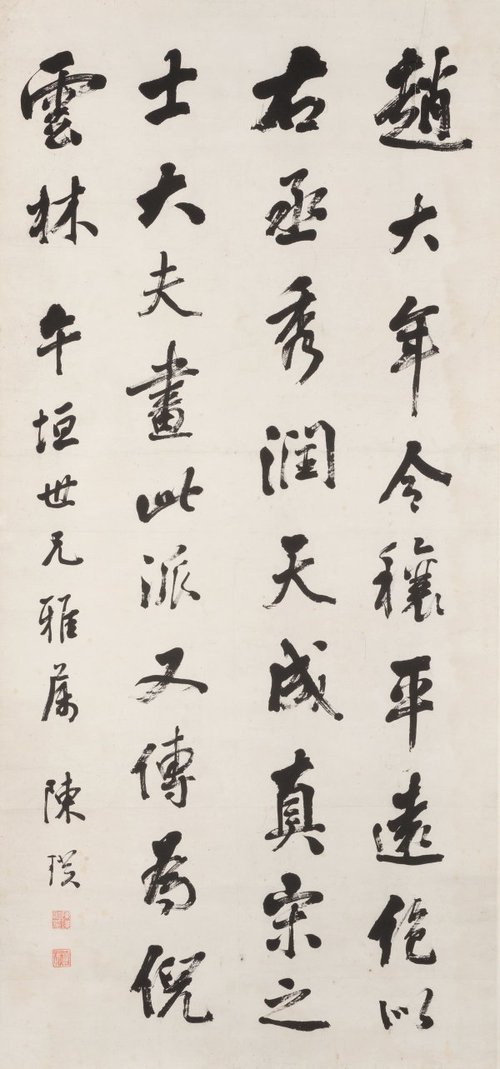

-
Details
- Place where the work was made
-
China
- Period
- Qing dynasty 1644 - 1911 → China
- Media categories
- Scroll , Calligraphy
- Materials used
- pair of hanging scrolls; ink on paper
- Dimensions
-
a - right scroll, 1681 x 271 cm, image
a - right scroll, 209 x 34.3 cm, scroll
b - left scroll, 1681 x 271 cm, image
b - left scroll, 209 x 34.3 cm, scroll
- Signature & date
Signed c.l. part b, in Chinese, inscribed in black ink "... Guqiao, Chen Pu, in the seventh moon of the year of Xinsi (1881)".
Signed l.l. part b, in Chinese, stamped in red ink “Chen Pu Shiyin [artist's seal]".
Signed l.l. part b, in Chinese, stamped in red ink “Chigang guiqiao [artist's seal]".- Credit
- Gift of Dr. James Hayes 2003
- Location
- Not on display
- Accession number
- 280.2003.a-b
- Copyright
- Artist information
-
Chen Pu
Works in the collection
- Share
-
-
About
‘A beautiful scene on a bright day; cheerful things delighting the mind;
Illustrious words and excellent brushes; an admirer of antiquity and man of great erudition.’
Inscription and signature: My nephew Tongjun has a natural manner; he is a person with lofty aspirations. Over the years he has collected a great many refined calligraphies and paintings. In his lifetime he has been a friend to many celebrities, having his bosom filled with boundless lofty sentiment. He requested I do a couplet for him; so I wrote these sixteen words as a reply. Inscribed by Chen Pu, style name Guqiao, in the seventh moon of the year 'Xinsi' [1881].The first line of this couplet was taken from prose written by Xie Lingyun (385–433), an eminent poet of the Southern dynasty, in which he wrote: ‘Under heaven, a bright day, a beautiful scene, delights for the mind and cheerful things – to find these four things together is not easy.’ Poetic expression was enshrined in popular culture by Tang Xianzu (1550–1616), an esteemed playwright from the Ming dynasty. Tang adapted the words of a song in one of his operas – in this case ‘The peony pavilion’, composed in the early 17th century, the song being sung by the heroine Du Liniang. The second line appears in Mi Fu’s colophon (written in 1087) on a handscroll entitled ‘Elegant gathering at western garden’, painted by his contemporary Li Gongling (1049–1106) (1). ‘Being an admirer of antiquity and a man of great erudition’ were the requirements established by Confucius for a pefect gentleman (in 'Analects'). Mi Fu used poetic expression to extol the lofty nature of scholars attending that gathering. It was such poetic expression, immersed in literary overtones, which Chen Pu singled out as a compliment to his nephew.
The couplet was written in Chen’s later years. His calm style of running script became bolder and more forceful, achieving a marvellous balance of self-expression and calligraphic technique. He used dry brush and swift sweeping strokes to create the effect of ‘fly-white’ (the rapid sweep of the brush leaving traces of white), thus imparting a roughness and vigour to the form.
1 Mi Fu, ‘A note to the painting “Elegant gathering at western garden (Xiyuan yaji tuji)" '.
‘The Poetic Mandarin: Chinese Calligraphy from the James Hayes Collection’. pg.75.
© 2005 Art Gallery of New South WalesThe couplet, written on two narrow pieces of paper or silk, and hung either side of a large painting or doorway, is one of the most common forms of calligraphic art and has a long standing history in China. They first appeared in the Five Dynasties period (907-979) as pairs of plaques, carved after written master copies, to decorate architectural columns, courtyards and garden doorways. Couplets for indoor display, written on paper or silk, came into existence in the 17th century and gained great popularity in the Qing dynasty. The couplets themselves are either taken from classical poetry or contemporary literary works composed by the calligraphers themselves and their friends. A couplet is made up of two parts called the head and the tail. The two lines of verse are antithetically parallel. Formerly it was a very common practice to send them to friends or relations on such occasions as marriages and birthdays, or as condolences to families of deceased persons.
Asian Art Department, AGNSW, August 2003.
-
Places
Where the work was made
China
-
Exhibition history
Shown in 1 exhibition
The poetic mandarin: Chinese calligraphy from the James Hayes collection, Art Gallery of New South Wales, Sydney, 23 Sep 2005–27 Nov 2005
-
Bibliography
Referenced in 1 publication
-
LIU Yang, The poetic mandarin: Chinese calligraphy from the James Hayes collection, Sydney, 2005, 74 (illus.), 75. cat.no. 15
-


